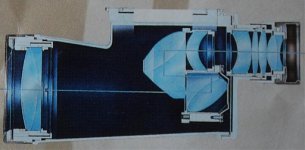Hi, all:
One thing I have never seen on such threads relates to the “non-existent perfection in manufacturing.” Having worked with Zemax-EE for years, and watching it go through its iterations in an effort to learn about the engineer I was never smart enough to be, I did note that when you are dealing with glass types, thicknesses of glass, kind and thickness of coatings, curvature of elements, knife edges, baffling and more, even the most minute deviation from the engineer’s computer-based design can lead to problems in the real-world image.
This puts not only a comparison of two binoculars of similar design and performance on the border of impractical and foolish (stacking BBs), it makes the comparison of two binoculars of the same model—produced on the same day—impractical and foolish as well, at least to the level so many on these forums want it to be. I’m sorry but reality bites. The photo attached is of a Nikon 7x50 SP. Counting the prisms, it has 24 surfaces, that may deviate ever so slightly in thickness, curvature, spacing, coatings, etc. in each telescope. And then, we must take into consideration that no two batches of glass—carrying the same formula designation—will be exactly the same. Sure, they’re very close; they have to be. But, are they a PERFECT match ... every time? And, how do all these deviations interact?
Finally, we have a piece of the puzzle that most handily recognize; we all have varying degrees of visual acuity and physiological accommodation. So, when you get to THE LEVEL OF “COMPARISON” SO OFTEN EXPECTED ON THESE FORUMS, just who has the eye/brain combination to make an authoritative assessment—optically, anyway?
I don’t pull the heads off baby chicks at Easter, push old ladies in front of busses, and I would like to be among friends. More than that, I know most will have forgotten or ignored my words by morning. But, because of the ½ of 1% of humble truth seekers, I put my head on the block COMMA ... again.
“The truth is incontrovertible. Malice may attack it, ignorance may deride it, but in the end, there it is.”—Winston Churchill
Bill




